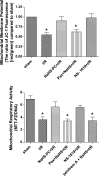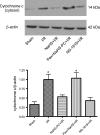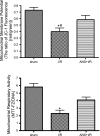Hydrogen sulfide preconditioning or neutrophil depletion attenuates ischemia-reperfusion-induced mitochondrial dysfunction in rat small intestine
- PMID: 21921289
- PMCID: PMC3345957
- DOI: 10.1152/ajpgi.00413.2010
Hydrogen sulfide preconditioning or neutrophil depletion attenuates ischemia-reperfusion-induced mitochondrial dysfunction in rat small intestine
Abstract
The objectives of this study were to determine whether neutrophil depletion with anti-neutrophil serum (ANS) or preconditioning with the hydrogen sulfide (H(2)S) donor NaHS (NaHS-PC) 24 h prior to ischemia-reperfusion (I/R) would prevent postischemic mitochondrial dysfunction in rat intestinal mucosa and, if so, whether calcium-activated, large conductance potassium (BK(Ca)) channels were involved in this protective effect. I/R was induced by 45-min occlusion of the superior mesenteric artery followed by 60-min reperfusion in rats preconditioned with NaHS (NaHS-PC) or a BK(Ca) channel activator (NS-1619-PC) 24 h earlier or treated with ANS. Mitochondrial function was assessed by measuring mitochondrial membrane potential, mitochondrial dehydrogenase function, and cytochrome c release. Mucosal myeloperoxidase (MPO) and TNF-α levels were also determined, as measures of postischemic inflammation. BK(Ca) expression in intestinal mucosa was detected by immunohistochemistry and Western blotting. I/R induced mitochondrial dysfunction and increased tissue MPO and TNF-α levels. Although mitochondrial dysfunction was attenuated by NaHS-PC or NS-1619-PC, the postischemic increases in mucosal MPO and TNF-α levels were not. The protective effect of NaHS-PC or NS-1619-PC on postischemic mitochondrial function was abolished by coincident treatment with BK(Ca) channel inhibitors. ANS prevented the I/R-induced increase in tissue MPO levels and reversed mitochondrial dysfunction. These data indicate that neutrophils play an essential role in I/R-induced mucosal mitochondrial dysfunction. In addition, NaHS-PC prevents postischemic mitochondrial dysfunction (but not inflammation) by a BK(Ca) channel-dependent mechanism.
Figures









Similar articles
-
Antecedent hydrogen sulfide elicits an anti-inflammatory phenotype in postischemic murine small intestine: role of BK channels.Am J Physiol Heart Circ Physiol. 2010 Nov;299(5):H1554-67. doi: 10.1152/ajpheart.01229.2009. Epub 2010 Sep 10. Am J Physiol Heart Circ Physiol. 2010. PMID: 20833953 Free PMC article.
-
Preconditioning with the BKCa channel activator NS-1619 prevents ischemia-reperfusion-induced inflammation and mucosal barrier dysfunction: roles for ROS and heme oxygenase-1.Am J Physiol Heart Circ Physiol. 2017 Nov 1;313(5):H988-H999. doi: 10.1152/ajpheart.00620.2016. Epub 2017 Aug 19. Am J Physiol Heart Circ Physiol. 2017. PMID: 28822969 Free PMC article.
-
Ischemic preconditioning attenuates ischemia-reperfusion-induced mucosal apoptosis by inhibiting the mitochondria-dependent pathway in rat small intestine.Am J Physiol Gastrointest Liver Physiol. 2004 Apr;286(4):G580-7. doi: 10.1152/ajpgi.00335.2003. Am J Physiol Gastrointest Liver Physiol. 2004. PMID: 15010362
-
Antecedent hydrogen sulfide elicits an anti-inflammatory phenotype in postischemic murine small intestine: role of heme oxygenase-1.Am J Physiol Heart Circ Physiol. 2011 Sep;301(3):H888-94. doi: 10.1152/ajpheart.00432.2010. Epub 2011 Jun 10. Am J Physiol Heart Circ Physiol. 2011. PMID: 21666111 Free PMC article.
-
Hydrogen sulfide as an endogenous modulator in mitochondria and mitochondria dysfunction.Oxid Med Cell Longev. 2012;2012:878052. doi: 10.1155/2012/878052. Epub 2012 Dec 5. Oxid Med Cell Longev. 2012. PMID: 23304257 Free PMC article. Review.
Cited by
-
The route and timing of hydrogen sulfide therapy critically impacts intestinal recovery following ischemia and reperfusion injury.J Pediatr Surg. 2018 Jun;53(6):1111-1117. doi: 10.1016/j.jpedsurg.2018.02.072. Epub 2018 Mar 6. J Pediatr Surg. 2018. PMID: 29622397 Free PMC article.
-
Cerebral Ischemia/Reperfusion Injury and Pharmacologic Preconditioning as a Means to Reduce Stroke-induced Inflammation and Damage.Neurochem Res. 2022 Dec;47(12):3598-3614. doi: 10.1007/s11064-022-03789-5. Epub 2022 Nov 3. Neurochem Res. 2022. PMID: 36327016 Review.
-
Involvement of volume-activated chloride channels in H2O 2 preconditioning against oxidant-induced injury through modulating cell volume regulation mechanisms and membrane permeability in PC12 cells.Mol Neurobiol. 2013 Aug;48(1):205-16. doi: 10.1007/s12035-013-8431-9. Epub 2013 Apr 2. Mol Neurobiol. 2013. PMID: 23546740
-
Hydrogen sulfide dilates rat mesenteric arteries by activating endothelial large-conductance Ca²⁺-activated K⁺ channels and smooth muscle Ca²⁺ sparks.Am J Physiol Heart Circ Physiol. 2013 Jun 1;304(11):H1446-54. doi: 10.1152/ajpheart.00506.2012. Epub 2013 Mar 22. Am J Physiol Heart Circ Physiol. 2013. PMID: 23525712 Free PMC article.
-
Preconditioning with soluble guanylate cyclase activation prevents postischemic inflammation and reduces nitrate tolerance in heme oxygenase-1 knockout mice.Am J Physiol Heart Circ Physiol. 2013 Aug 15;305(4):H521-32. doi: 10.1152/ajpheart.00810.2012. Epub 2013 Jun 14. Am J Physiol Heart Circ Physiol. 2013. PMID: 23771693 Free PMC article.
References
-
- Boehning D, Snyder S. Novel neural modulators. Annu Rev Neurosci 26: 105–131, 2003 - PubMed
-
- Cho J, Won K, Wu D, Soong Y, Liu S, Szeto HH, Hong MK. Potent mitochondria-targeted peptides reduce myocardial infarction in rats. Coron Artery Dis 18: 215–220, 2007 - PubMed
-
- Cooper D, Russell J, Chitman KD, Williams MC, Wolf RE, Granger DN. Leukocyte dependence of platelet adhesion in postcapillary venules. Am J Physiol Heart Circ Physiol 286: H1895–H1900, 2004 - PubMed
-
- Douglas RM, Lai JC, Bian S, Cummins L, Moczydlowski E, Haddad GG. The calcium-sensitive large-conductance potassium channel (BK/MAXI K) is present in the inner mitochondrial membrane of rat brain. Neuroscience 139: 1249–1261, 2006 - PubMed
Publication types
MeSH terms
Substances
Grants and funding
LinkOut - more resources
Full Text Sources
Medical
Research Materials
Miscellaneous

